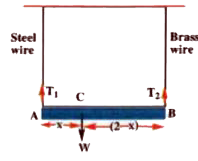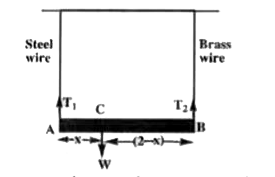A light rod of length 2m is suspended horizontally by means of 2 vertical wires of equal lengths tied to its ends. One of the wire is made of steel & is of cross section A1=0.1cm2 & other of brass & is of cross section A2=0.2cm2, find out the position along the rod at which a weight must be suspended to produce (i) equal stresses in both wires, (ii) equal strains in both wires for steel, y=20×1010Nm−2 & for brass y=10×1010Nm−2.Solution in Tamil
The situation in diagram
Let & B be a rod of length 2m suppose a weight W is hung at C at a distance x from A. Let T1 & T2 be the tension in the steel & brass rods.
(i) stress in steel wire =T1A1
stress in brass wire = T2A2
as both the stresses are equal, so
T1A1=T2A2 or T1T2=A1A2

=0.10.2=12
Now moments about C are equals as the system is in equilibrium
T1=T2(2−x) or T1T2=2−xx
12=2−xx
x=4−2x
3x=4 or x=43=1.33m
(ii) Now y=stressstrain
∴strain=stressy
strain in steel wire =T1/A1y
strain in brass wire =T2/A2y
Now, T1A1y1=T2A2y2:T1T2=A1y1A2y2
=0.1cm2×20×1010Nm−20.2m2×10×1010Nm−2=1
again, T1x=T2(2−x)
1=2−xx
x=2−x
2x=2 or x = 1m
Topper's Solved these Questions
- BOOK - SURA PUBLICATIONCHAPTER - PROPERTIES OF MATTEREXERCISE - Value based Questions5videos
PROPERTIES OF MATTER
- BOOK - SURA PUBLICATIONCHAPTER - PROPERTIES OF MATTEREXERCISE - Numerical Problems13videos
PROPERTIES OF MATTER
- BOOK - SURA PUBLICATIONCHAPTER - OSCILLATIONSEXERCISE - VALUE BASED QUESTIONS2videos
OSCILLATIONS
- BOOK - SURA PUBLICATIONCHAPTER - PUBLIC EXAM QUESTION PAPER MARCH-2019EXERCISE - Part-IV10videos
PUBLIC EXAM QUESTION PAPER MARCH-2019
Similar Questions
the r.m.s. velocity of the molecules of a certain diatomic gas is found to be 1.6 Km/sec. the gas is
06:15View SolutionThe poisson ratio of a material is 0.5 if a force is applied to a wire of this material, there is a decrease in the cross sectional area by 4% what is the percentage increases in the length.
05:44View SolutionStudent in a class were asked by their science teacher about different types of motion , with Examples. But few students were confused with explanation ,for example . Periodic motion. SHM , Oscillatory motion , Rotational motion. SHM , Oscillatory motion . Periodic motion, etc. How would have the teacher explained , so the students understood easily ?
(i) What are path difference & phase difference ?
(ii) For the waves , given below find out the phase & path differences.
 04:04View Solution
04:04View SolutionThe force F acting on a body moving in a circular path depends on mass of the body (m) velocity(v) and radius (r) of the circular path. Obtain the expression for the force by dimensional analysis method (k=1)
03:44View SolutionA light rod of length of length 2m is suspended from a ceiling horizontally by means of two vertical wires of equal length tied to its ends. One of the wires is made of steel and is of cross - section 10−3m2 and the other is of brass of cross- section 2×10−3m2.x is the distance from the steel wire end, at which a weight may be hung. Ysteel=2×1011PaandYbrass=1011Pa
Which of the following statement(s) is /are correct ?View SolutionA light rod of length 2m is suspended from the ceiling horizontally by means of two vertical wires of equal length tied to its ends. One of the wires is made of steel and is of cross section 0.1cm2. The other wire is a brass of cross section 0.2cm2. A weight is suspended from a certain point of the rod such that equal stress are produced in both the wires. Which of the following are correct?
View SolutionA light rod of length 2 m is suspended ceiling horizontally by means of two vertical wires of equal length tied to its ends. One of the wires is ade of steel and is of cross-section 0.1 cm and the other of brass of cross-section 0.2 cm. Along the rod at what distance a weight may be hung to produce stresses in the wires? (Y_("Steel") = 2 xx 10^(11) Nm^(-2), Y_("Bass") = 1 xx 10^(11) Nm^(-2))
View SolutionA light rod of length 4.0 m is suspended from the ceiling horizontally by means of two vertical wire of equal length tied to its ends. One of the wires is made of steel and is of cross-section 10−3m2 and the other is of brass of cross-section 2×10−3m2. Find out the position along the rod at which a weight may be hung to produce equal stresses in both wires.
View SolutionA light rod of length 2 m is suspended from the ceiling horizontally by means of two vertical wires of equal length tied to its ends. One of the wire is made of steel and is cross section 10−3m2 and the other is of brass of cross section 2×10−3m2 . Young's modulus for steel is 2×1011N.m−2 and for brass is 1011N.m−2.
Find out the position along the rod at which a weight may be hung to produce equal stress in both wires.View SolutionA light rod of length 2 m is suspended from the ceiling horizontally by means of two vertical wires of equal length tied to its ends. One of the wire is made of steel and is cross section 10^-3 m^2 and the other is of brass of cross section 2 times 10^-3 m^2 . Young's modulus for steel is 2 times 10^11 N.m^-2 and for brass is 10^11 N.m^-2 . Find out the position along the rod at which a weight may be hung to produce equals strains on both wires
05:40View SolutionA light rod of length 200cm is suspended from the ceiling horizontally by means of two vertical wires of equal length tied to its ends. One of the wires is made of steel and is of cross-section 0.1cm^(2) and the other of brass of cross-section 0.2 cm^(2) . A distance long the rod at which a weight may be hung to produce equal stresses in both the wires?
View SolutionA light rod of length 2 m is suspended from the ceiling horizontally by means of two vertical wires of equal length tied to its ends. One of the wires is made of steel and is of cross-section 10^(-3) m^2 and the other is of brass of cross-section 2 xx 10^(-3) m^2 . Find out the position along the rod at which a weight may be hung to produce, i) equal stress in both wires ii) equal strains in both wires Young's modulus of brass = 1 xx 10^11 N//m^2 Young's modulus of steel = 2 xx 10^11 N//m^2
05:43View SolutionA light rod of length 2 m is suspended from the ceiling horizontally by means of two vertical wires of equal length tied to its ends. One of Steel the wires is made of steel and is of cross-section 10−3m2 and the other wire is of brass of cross-section 2×10−3m2. Find out the position along the rod at which a weight may be hung to produce:
(i) equal stress in both wires
(ii) equal strains in both wires
Young.s modulus of brass = 1×1011N/m2
Young.s modulus of steel =2×1011N/m2
 View Solution
View SolutionA light rod of length 2 m is suspended from ceiling horizontally by means of two vertical wires of equal length tied to its ends. One of the wires is made of steel and is of cross-section 0.1 cm sq. and the other of brass of cross-section 0.2 cm sq. Along the rod at what distance a weight may be hung to produce equal stresses in the wires? (Y_("Steel") = 2 xx 10^(11) Nm^(-2), Y_("Bass") = 1 xx 10^(11) Nm^(-2))
05:58View SolutionA light rod of length 2 m is suspended from the ceiling horizontally by mean.s of two vertical wires of equal length tied to its ends. One of the wires is made of steel and is of cross-section 10−3m2 and the other is of brass of cross -section 2×10−3m2. Find out the position along of corss-section 2×10−3m2. Find out the position along the rod at which a weight may be hung to produce, (i) equal stress in both wires (ii) equal strains in both wires
Young.s modulus of brass =1×1011N/m2
Young.s modulus of steel =2×1011N/m2
 05:32View Solution
05:32View Solution

